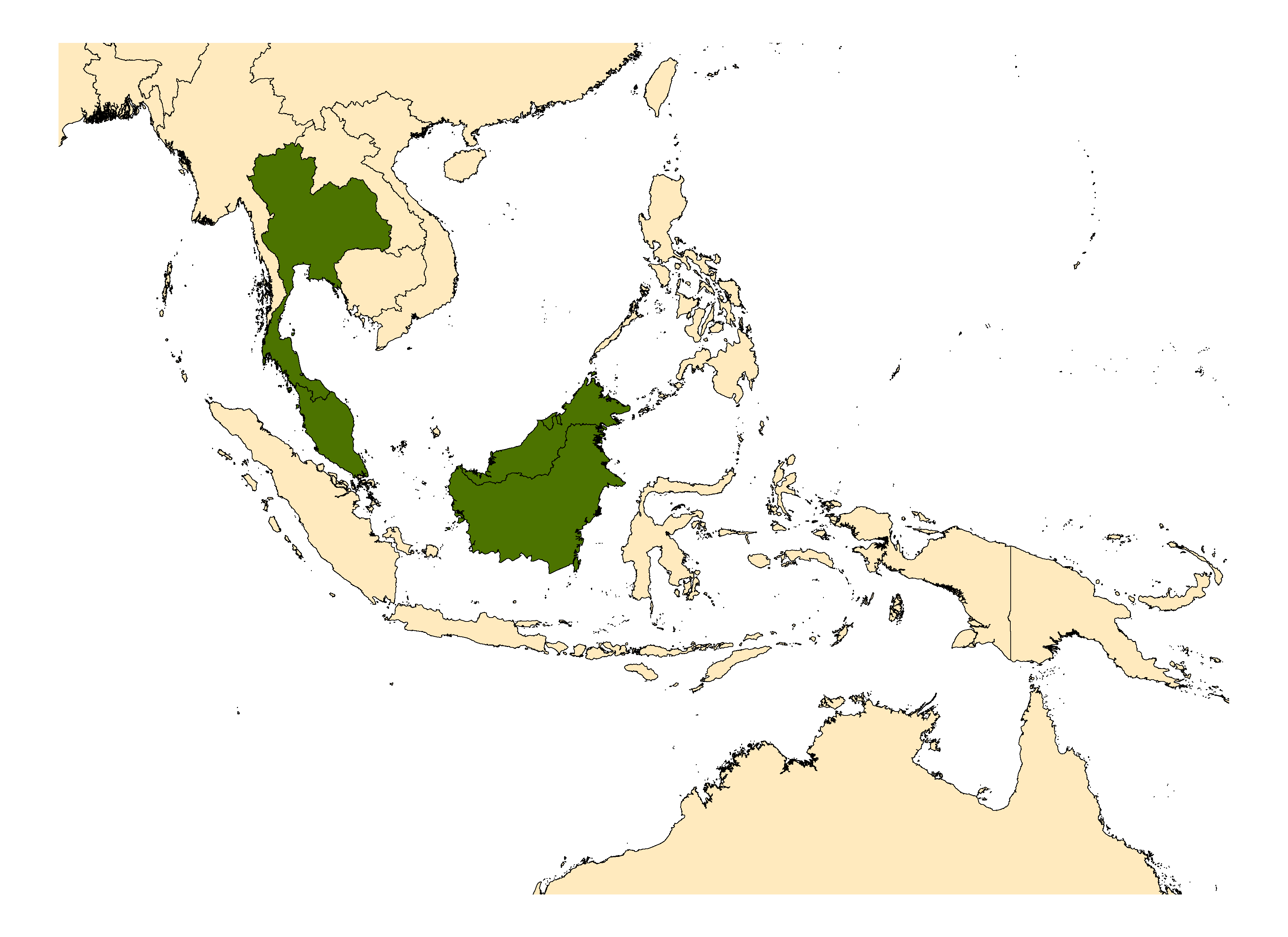ORIENTAL REGION
Etymology: concealed, hidden (L); hidden under An. leucosphyrus
Anopheles latens is a striking mosquito, beautifully pebble-dashed with small pale scale patches on the legs (see a), white hind “knees”, and an intricate dark-light mosaic pattern on the wings. The species was long hidden under An. leucosphyrus Dönitz, until chromosomal studies indicated the presence of two cytotypes, and An. latens (formerly An. leucosphyrus A) was formally described. Anopheles leucosphyrus and An. latens are morphologically identical as adults, pupae and larvae. The established range of An. latens stretches from the forests of southern Thailand, through peninsular Malaysia and into the northern and east parts of Borneo, whereas An. leucosphyrus s.s. is limited to Sumatra. Together with An. baisasi Colless, An. balabacensis Baisas, An. introlatus Colless, An. latens and An. leucosphyrus comprise the Leucosphyrus Complex.
Type locality: Phangnga, Ban Bang Kaeo, Thailand
Type depository: U.S. National Museum, Washington, D.C., United States (USNM)
DIAGNOSTIC CHARACTERS (Click photos to view; mouse over and click large photo to zoom in.)
ADULT (illustrated): Head: Proboscis (P) slightly longer than forefemur; MPlp5 apical pale band distinctly light cream-colored, contrasting with silvery-white bands on MPlp2,3. Wing: Presector dark spot of vein R entirely dark or with 1–5 pale interruptions; accessory sector pale spot usually extending onto vein C on at least 1 wing; veins M3+4 and M noticeably wavy; fork of cell R2 in line or basal to fork of cell M1+2; fringe with pale spot between veins 1A and CuA. Legs: Apex of Ti-III and base of Ta-III1 with large white band; Ta-III4 without basal pale band; Ta-III5 with apical pale band.
LARVA (not illustrated): Head: Seta 3-C single; seta 5-C conspicuously longer than antenna. Thorax: Basal sclerotized tubercle of seta 1-P without prominent tooth or spine arising from posterodorsal margin, conspicuously smaller than that of seta 2-P; setae 1,2-P basal sclerotized tubercles usually separate, distance between bases wide, equal to or greater than basal width of tubercle of seta 1-P. Abdominal segments: Seta 1-II not fully developed, noticeably smaller than seta 1-III–VI.
TAXONOMIC KEYS
None
![]()
WRBU - Genera - Global - Larva
![]()
WRBU - Genera - Indomalaya - Adult
![]()
WRBU - Genera - Indomalaya - Larva
![]()
WRBU - Genera - Oriental - Adult
![]()
WRBU - Genera - Oriental - Larva
![]()
WRBU - Anopheles Subgenera and Series - Indomalaya - Adult
![]()
WRBU - Anopheles Subgenera and Series - Indomalaya - Larva
![]()
WRBU - Anopheles Subgenera and Series - Oriental - Adult
![]()
WRBU - Anopheles Subgenera and Series - Oriental - Larva
![]()
WRBU - Anopheles (Cel.) Neomyzomyia Series - Indomalaya - Adult
![]()
WRBU - Anopheles (Cel.) Neomyzomyia Series - Indomalaya - Larva
![]()
WRBU - Anopheles (Cel.) Neomyzomyia Series - Oriental - Adult
![]()
WRBU - Anopheles (Cel.) Neomyzomyia Series - Oriental - Larva
Exemplar DNA sequences
An. latens COI: DQ897936-37; ITS2: MG008596-612
An. leucosphyrus COI: DQ897939; NADH6: DQ899798-99
BIONOMICS
Immatures
Immature An. latens have been found in small, shaded temporary forest pools, pools, stream pools in forest streams, and tree-covered swamps. Little is known on the true bionomics of An. leucosphyrus.
Adults
Anopheles latens is a primary vector of human malaria (Plasmodium falciparum, P. vivax) in the Malaysian State of Sarawak, NE Borneo. It is a forest mosquito, known to feed both on monkeys and people outdoors, and readily enter houses late at night to feed on man. This plasticity in feeding preference is of concern in forested areas, where it is also a proven vector in the novel foci of P. knowlesi (a simian malaria) to man in Sarawak, Borneo.
DISTRIBUTION NOTES
Indonesia, Malaysia (includes Sabah, Borneo), Thailand.

WRBU VECTOR HAZARD REPORTS
None; View other WRBU Vector Hazard Reports
Available GIS Models
None
IMPORTANT REFERENCES (full citations below)
Sallum & Peyton 2005 in Sallum et al. 2005a: 160 (M, F, P*, L*)
Rattanarithikul et al. 2006b (F*, L*; bionomics, distribution, keys)
Vythilingam et al. 2006 (bionomics, incrimination with P. knowlesi)
Sallum et al. 2007: 30 (phylogeny)
Tan et al. 2008 (bionomics)
Sinka et al. 2011: 89 (bionomics review, distribution, niche model)
CURRENT SYNONYMS
None
CURRENT SUBSPECIES
None
CITED REFERENCES
Rattanarithikul, R., Harrison, B.A., Harbach, R.E., Panthusiri, P., & Coleman, R.E. (2006b). Illustrated keys to the mosquitoes of Thailand. IV. Anopheles. Southeast Asian Journal of Tropical Medicine and Public Health, 128(Supplement 2), 2.
Sallum, M.A.M., Peyton, E. L., & Wilkerson, R.C. (2005a). Six new species of the Anopheles leucosphyrus group, reinterpretation of An. elegans and vector implications. Medical and Veterinary Entomology, 19, 158–199.
Sallum, M. A. M., Foster, P.G., Li, C., Sithiprasasna, R., & Wilkerson, R.C. (2007). Phylogeny of the Leucosphyrus Group of Anopheles (Cellia) (Diptera: Culicidae) based on mitochondrial gene sequences. Annals of the Entomological Society of America, 100(1), 27–35.
Sinka, M.E., Bangs, M.J., Manguin, S., Chareonviriyaphap, T., Patil, A.P., Temperley, W.H., ... Hay, S.I. (2011). The dominant Anopheles vectors of human malaria in the Asia-Pacific region: Occurrence data, distribution maps and bionomic précis. Parasites & Vectors, 4(1), 89.
Tan, C.H., Vythilingam, I., Matusop, A., Chan, S.T. & Singh, B. (2008). Bionomics of Anopheles latens in Kapit, Sarawak, Malaysian Borneo in relation to the transmission of zoonotic simian malaria parasite Plasmodium knowlesi. Malaria Journal, 7, 52.
Vythilingam, I., Tan, C.H., Asmad, M., Chan, S.T., Lee, K.S. & Singh, B. (2006). Natural transmission of Plasmodium knowlesi to humans by Anopheles latens in Sarawak, Malaysia. Transactions of the Royal Society of Tropical Medicine and Hygiene, 100, 1087—1088.
CITE THIS PAGE
Walter Reed Biosystematics Unit (Year). Anopheles latens species page. Walter Reed Biosystematics Unit Website, http://wrbu.si.edu/vectorspecies/mosquitoes/latens, accessed on [date (e.g. 03 February 2020) when you last viewed the site].









































































































































































